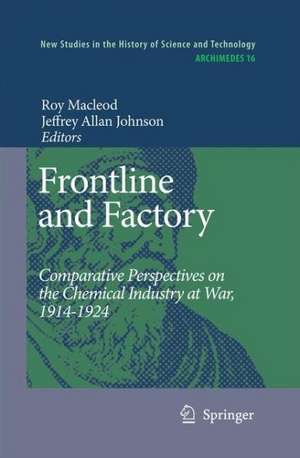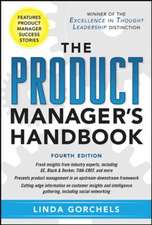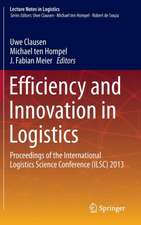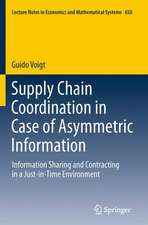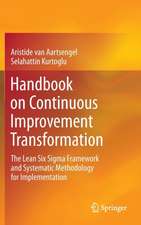Frontline and Factory: Comparative Perspectives on the Chemical Industry at War, 1914-1924: Archimedes, cartea 16
Editat de Roy MacLeod, Jeffrey A. Johnsonen Limba Engleză Paperback – 21 oct 2014
| Toate formatele și edițiile | Preț | Express |
|---|---|---|
| Paperback (1) | 1108.04 lei 6-8 săpt. | |
| SPRINGER NETHERLANDS – 21 oct 2014 | 1108.04 lei 6-8 săpt. | |
| Hardback (1) | 1114.02 lei 6-8 săpt. | |
| SPRINGER NETHERLANDS – 28 feb 2007 | 1114.02 lei 6-8 săpt. |
Din seria Archimedes
- 5%
 Preț: 909.01 lei
Preț: 909.01 lei - 18%
 Preț: 899.21 lei
Preț: 899.21 lei - 18%
 Preț: 785.55 lei
Preț: 785.55 lei -
 Preț: 382.36 lei
Preț: 382.36 lei - 18%
 Preț: 1833.33 lei
Preț: 1833.33 lei - 15%
 Preț: 643.84 lei
Preț: 643.84 lei - 18%
 Preț: 951.77 lei
Preț: 951.77 lei - 15%
 Preț: 645.79 lei
Preț: 645.79 lei - 15%
 Preț: 644.30 lei
Preț: 644.30 lei - 20%
 Preț: 577.17 lei
Preț: 577.17 lei - 15%
 Preț: 646.62 lei
Preț: 646.62 lei - 18%
 Preț: 1110.09 lei
Preț: 1110.09 lei - 18%
 Preț: 1216.65 lei
Preț: 1216.65 lei - 18%
 Preț: 730.02 lei
Preț: 730.02 lei - 18%
 Preț: 1552.22 lei
Preț: 1552.22 lei - 18%
 Preț: 891.48 lei
Preț: 891.48 lei - 18%
 Preț: 776.88 lei
Preț: 776.88 lei - 18%
 Preț: 1214.60 lei
Preț: 1214.60 lei - 18%
 Preț: 1113.26 lei
Preț: 1113.26 lei - 18%
 Preț: 777.69 lei
Preț: 777.69 lei - 18%
 Preț: 995.83 lei
Preț: 995.83 lei - 15%
 Preț: 635.47 lei
Preț: 635.47 lei - 24%
 Preț: 1459.25 lei
Preț: 1459.25 lei - 18%
 Preț: 948.47 lei
Preț: 948.47 lei - 18%
 Preț: 1666.97 lei
Preț: 1666.97 lei - 18%
 Preț: 1114.83 lei
Preț: 1114.83 lei - 15%
 Preț: 645.60 lei
Preț: 645.60 lei
Preț: 1108.04 lei
Preț vechi: 1351.28 lei
-18% Nou
Puncte Express: 1662
Preț estimativ în valută:
212.05€ • 221.10$ • 176.23£
212.05€ • 221.10$ • 176.23£
Carte tipărită la comandă
Livrare economică 21 martie-04 aprilie
Preluare comenzi: 021 569.72.76
Specificații
ISBN-13: 9789400790964
ISBN-10: 9400790961
Pagini: 300
Ilustrații: XIX, 279 p.
Dimensiuni: 155 x 235 x 16 mm
Greutate: 0.42 kg
Ediția:2006
Editura: SPRINGER NETHERLANDS
Colecția Springer
Seria Archimedes
Locul publicării:Dordrecht, Netherlands
ISBN-10: 9400790961
Pagini: 300
Ilustrații: XIX, 279 p.
Dimensiuni: 155 x 235 x 16 mm
Greutate: 0.42 kg
Ediția:2006
Editura: SPRINGER NETHERLANDS
Colecția Springer
Seria Archimedes
Locul publicării:Dordrecht, Netherlands
Public țintă
ResearchCuprins
Technological Mobilization and Munitions Production: Comparative Perspectives on Germany and Austria.- Mobilization and Industrial Policy: Chemicals and Pharmaceuticals In The French War Effort.- First World War Explosives Manufacture: The British Experience.- Transforming a Village into an Industrial Town: The Royal Prussian Powder Plant in Kirchmöser (Brandenburg).- Wartime Chemistry in Italy: Industry, the Military, and the Professors.- Munitions, the Military, and Chemistry in Russia.- Technical Expertise and U.S. Mobilization, 1917–18: High Explosives and War Gases.- Operating on Several Fronts: The Trans-National Activities of Royal Dutch/Shell, 1914–1918.- Kuhlmann at War, 1914–1924.- Organizing for Total War: DuPont and Smokeless Powder in World War I.- Science and the Military: The Kaiser Wilhelm Foundation for Military-Technical Science.- Managing Chemical Expertise: The Laboratories of the French Artillery and the Service des Poudres.- The War the Victors Lost: The Dilemmas of Chemical Disarmament, 1919–1926.
Textul de pe ultima copertă
The First World War is often called the ‘chemists’ war’. But few realise precisely how, or the extent to which modern chemistry became a significant factor in the struggle, and would be in turn deeply shaped by it. Gathering momentum at first, by 1916, success in applying scientific knowledge to ‘frontline and factory’ became a measure of a nation’s capacity to win an industrial war. In the end, the titanic contest was won in large part through the command of raw materials and industrial output. This book represents a first considered attempt to study the factors that conditioned industrial chemistry for war in1914-18. Taking a comparative perspective, it reflects on the experience of France, Germany, Austria, Russia, Britain, Italy and Russia, and points to significant similarities and differences. It looks at changing patterns in the organisation of industry, and at the emerging symbiosis between science, industry and the military, which contributed to the first ‘academic-military-industrial’ complex of the 20th century. At the same time, it reflects on the world’s first, and ultimately unsuccessful attempt to monitor ‘dual-use’ chemical technologies, and so restrict the proliferation of an important category of weapons of mass destruction.
Caracteristici
The first comparative study of the mobilisation of the international chemical industry for war, 1914-18 The first study to show the ‘chemists’ war’ as a war not only waged with chemical weapons, but also driven with the full force of international chemistry A challenging essay in industrial and technological history, to be read alongside more conventional accounts of military campaigns and wartime developments in the political, economic and social spheres
